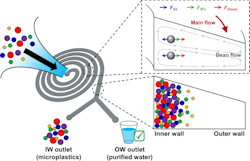Key Highlights
- The spiral inertial device uses inertial lift and drag forces to separate microplastics without membranes, reducing clogging and maintenance issues.
- Testing showed removal efficiencies of up to 99% for particles between 10-40 micrometers and 85-98% for smaller particles below 10 micrometers.
- The system's design allows stacking and recycling, making it suitable for high-volume water treatment with minimal wear and long lifespan.
Microplastics (MP) are particles less than 5 millimeters long, about the thickness of a pencil eraser, that are sloughed off by our constant use of plastic products. While Styrofoam containers and sandwich bags are common plastics, some are less obvious. A single piece of clothing may produce an estimated 1,900 fibers in each wash. While water treatment processes filter out the larger pieces, the micro and nano-sized particles end up in our sanitary wastewater and ultimately, to our rivers, lakes, and oceans.
With the intent to improve microplastic removal, a team of researchers from MIT designed and tested a membrane-free microplastic removal system. The aim of the 2025 study was to test a high-flow, membrane-free spiral device and see how well microplastics separated out according to particle size. This is “filtration without filtration,” says Jongyoon Han, PhD, MIT Professor of Electrical and Biological Engineering and an author of the study.
According to a 2020 study, the typical wastewater treatment process removes an average of 72% of microplastics, leaving countless particles discharged to waterways, where they can enter the food chain or settle to the bottom and leach chemical contaminants into the environment. But that’s not the only pathway. Some microplastic particles can chemically bind with bacteria during secondary treatment. Depending on the type of plastic and other variables such as UV exposure, bio-sludge contact time, and the shape of individual microplastic flakes, degradation and leached contaminants differ greatly. Trapped microplastic and associated contaminants remain in the bio-sludge. If the bio-sludge is disposed by land application for agricultural reuse as fertilizer, the microplastic and contaminates go into the soil, creating another exposure cycle. While toxicity studies are underway, engineering solutions for MP removal are the first line of defense.
A literature review of MP removal strategies, published in 2024, revealed a steady increase in removal studies since 2015. The consensus is that filtration, particularly in freshwater, achieves high MP removal, is cost effective, and easy to operate. Sand, activated carbon, and biochar provide effective removal, but the smallest particles may require micro or ultrafiltration, which increases the operation and maintenance costs.
A major consideration is matching the filtering media with the chemistry of the specific plastic. Generated MP can be hydrophilic or hydrophobic, requiring different filtration media. Water in commercial or municipal wastewater systems will contain both, making effective removal more complex and costly.
Flow rate plays a vital role in optimizing MP removal efficiency: too fast and there is not enough contact time with the filtration media, too slow and the system can clog. Filtration is a viable solution, but multi-filtration steps can make for complicated engineering and increased costs. But it’s not the only solution.
Membrane-free microplastic removal utilizing a multiplexed spiral inertial microfluidic device sounds like a complex engineering nightmare but is in fact an elegant solution using the physics principles of inertial lift and drag. In the figure, microplastic laden water is introduced into a spiral device with angular walls. There are two outlets, one for clean water and one for the collection of particles. The lateral movement on the microplastic creates inertial lift and drag forces according to particle size, creating a balance known as “inertial migration or inertial focusing.” Spirals can be stacked and configured in parallel and in series for maximum removal efficiency without clogging. The clean water outlet can be looped back to the inlet for repeated cycles. This advantage explains Dr. Han, allows the filtration of small particles in a high volume of water and concentrates it into a form that perhaps can be recycled, or reused.
In addition to being less likely to clog, the spiral system has other benefits over membrane-based filtration. While a 10-year life cycle was stated in the study, there is no reason why it can’t run much longer, according to Han. There is also no limitation on the raw materials used to fabricate the device. Ironically, the spirals used for the study are made of polystyrene, a plastic that’s economical, each to shape, and simple to mass produce. Yet, for commercial operations, the spirals could be made from metal, stainless steel, glass, or other types of plastic, depending on the intended use.
In this study, fifty spiral devices were stacked together to demonstrate the success of a 10-liter high input flow with an output of clean water at 125mL/min. This study not only confirmed the design’s success but pointed out one of the few limitations. Dr. Han said that the device becomes difficult to run when dealing with particles smaller than 2 or 3µm. This is where a membrane filter system could be employed to capture microplastic smaller than 3µm. Starting with a cleaner input, micro or ultrafiltering membranes could be employed with decreased clogging as well as lower operational and maintenance costs.
To determine microplastic removal efficiency of different particle sizes, three size regimes were tested. The first contained particles between 10-40 µm with a particle removal efficiency of 99%. The second contained particles below 10µm. Due to the weakened inertial forces, the removal efficiency was reduced but still achieved 85-98% capture. The last regime tested particle sizes above 40µm with removal efficiencies of 78-96%. This decreased efficiency can be attributed to the point where the channel dimensions and degree of angle approach the upper limit of the particle size, an event known as the “large particle trapping effect.” Sequential particle removal utilizing multiple spiral devices of different diameters could alleviate this constraint.
While a membrane filtration system may be inhibited by the physicochemical properties of the MP, such as the attraction or rejection of water molecules and organic matter, the spiral device is non-contact filtration based on particle size. Particle chemistry is less of a concern.
More of an obstacle for Han is acquiring research money for further testing of the spiral inertial system. Han points out that the wastewater engineering industry is well established and very successful in wastewater treatment, but sometimes reluctant to adopt new technology. There is a good reason for this.
Publicly owned wastewater treatment plants have limitations of their own. John Schadal, Communications Professional with Metropolitan Council Environmental Services (MCES) explained in an e-mail that new or different technologies must go through a rigorous evaluation scientifically, and financially before public funds can be allocated. They are also bound by regulations, which at this point do not limit microplastics in wastewater. In Minnesota, MCES operates nine WWTPs. While MCES recognizes the MP issue, the public process for change takes time.
Still, the spiral inertial system is a demonstrated success. It is Dr. Han’s hope that the wastewater treatment industry will give it a try.
About the Author

Lisa Polos
Lisa Polos is an environmental scientist with forty years of experience in waste, water, and air compliance, primarily for the petroleum and chemical industries. She is also a freelance writer focused on environmental engineering solutions. Ms. Polos lives in St. Paul, Minnesota.

